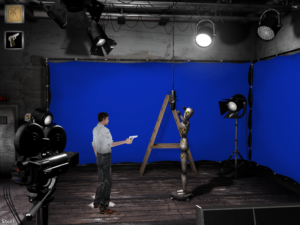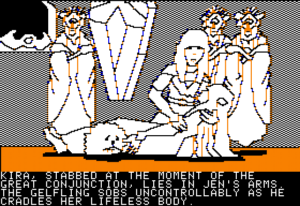Kinoautomat
Earlier today, Paolo Pedercini hosted an “interactive movie night” on the Molleindustria Twitch channel, using Twitch’s features to poll the people watching about choices. I of course had to watch. Four pieces were screened: Kinoautomat, I’m Your Man, an adaptation of the shoot from Steven Spielberg’s Director’s Chair, and The Immoral Ms. Conduct. As of this writing, the recorded stream is still available, although obviously not interactive.
I mainly want to talk specifically about Kinoautomat, a black-and-white Czech comedy that first screened at the 1967 World’s Fair in Montreal. This is a piece I had been curious about for some time, but had never had a chance to see. As far as anyone knows, it’s the first work of interactive cinema ever attempted — although later claimants to that distinction can be forgiven for not knowing about it, because it was simply unavailable for decades, having been banned by the Czech Communist Party. In its original form, it would have had a live presenter narrating the choices, telling the audience which buttons to press for each choice. Interactivity was thus seen as something operating on the film from outside, rather than a part of the content. It’s a bit ironic, too, to put “automat” in the title and then make it depend on direct human interaction. In the form presented to us today, however, the presenter is part of the video, clearly a later addition. The original filmmakers could have done it this way — the film was still running while the presenter talked — but chose not to. Call it a UI decision.
In form, it’s very close to linear: despite some pretentions of being controlled by a complex computer (which speaks directly to the audience at the end), the interactivity was originally created by running two film projectors simultaneously and blocking one of them at a time. (Apparently it was also once televised using two channels.) So, your choices can’t affect the sequence of events for very long. This isn’t much of a surprise, though, because the bulk of the story is told in flashback: the whole thing starts with an apartment block on fire, followed by recounting the events that led up to it. Apparently it’s been read as a satire of democracy. No matter what you vote for, it all ends in flames.
The style is goofy and extremely 1960s in its sensibilities — most of the story concerns a respectable middle-aged man dealing with being caught in the company of a naked woman for completely innocent reasons and Everyone Getting The Wrong Impression. That man, Mr. Novák, is the viewpoint character, but interestingly, not all of the choices concern his actions: in the end, the audience is asked to simply pass judgment on him, decide whether he’s culpable for the fire or not, a choice that basically asks you to end any identification you had with him. (Personally, I was strangely disappointed when it turned out that he didn’t start the fire deliberately.) Also, at one point the doorbell rings and the audience is polled for their guesses about who it is. Neither of the options offered is right, and the only effect of the choice is the display of how many people chose what. So even at this early date, designers were using completely fake choices to split up lengthy noninteractive sections.
I feel like the filmmakers showed a lack of confidence in the format when they decided to make Kinoautomat a goofball comedy, unsure about whether audiences would be willing to take interactivity seriously. That’s pretty definitely the case for I’m Your Man, the second “world’s first interactive movie”, which was specifically intended as a test of audiences, and which turns up the goof factor to the point where it’s using cartoon sound effects. I’d also like to note that I’m Your Man doesn’t bind its audience to making choices for a single player character, switching characters freely — indeed, its first several choices are choices of whose story to follow. Film, after all, has no technical constraints limiting who can act on your decisions. And yet Kinoautomat mostly sticks to the CYOA model, despite predating the Choose Your Own Adventure series by a decade.
 0 Comments
0 Comments
